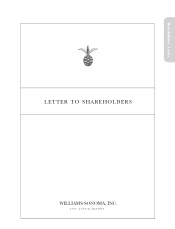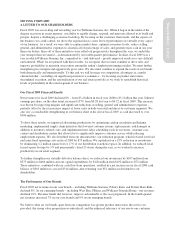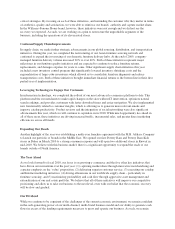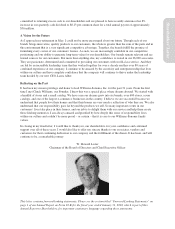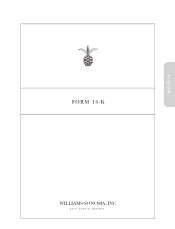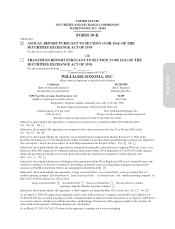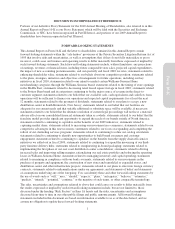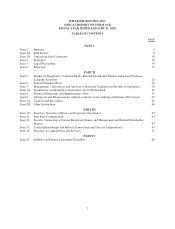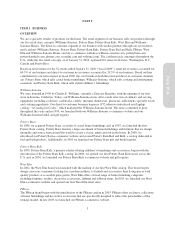Pottery Barn 2009 Annual Report Download - page 5
Download and view the complete annual report
Please find page 5 of the 2009 Pottery Barn annual report below. You can navigate through the pages in the report by either clicking on the pages listed below, or by using the keyword search tool below to find specific information within the annual report.
MOVING FORWARD
A LETTER TO OUR SHAREHOLDERS
Fiscal 2009 was an exciting and rewarding year for Williams-Sonoma, Inc. While it began in the midst of the
deepest recession in recent memory, our ability to rapidly change, respond, and innovate allowed us to build and
prosper, despite a challenging economic backdrop. By focusing on the customer, their needs, and the aspects of
the business we could control, we drove the organization to a new level of performance in virtually every aspect
of our business. As a result, we were able to capture market share; optimize inventory levels; reduce selling,
general, and administrative expenses to a historical low percentage of sales; and generate more cash in one year
than ever before. Since all of these initiatives were rolled out progressively throughout the year, we ended the
year stronger than we started – as demonstrated by our fourth quarter performance. In short, fiscal 2009 was a
year in which Williams-Sonoma, Inc. committed to – and delivered – greatly improved results in a very difficult
environment. While we are pleased with these results, we recognize that we must continue to drive sales and
improve profitability to maintain our position among the nation’s highest performing retailers. We must further
strengthen gross margins and aggressively grow sales. We also must continue to expand the reach of our brands
both domestically and internationally. To this end, we will leverage our competitive advantages as a multi-
channel retailer – including our significant position in e-commerce – by focusing on product innovation,
streamlined execution, and the rationalization of our real estate portfolio as we work to reestablish historical
levels of profitability in the retail segment of our business.
Our Fiscal 2009 Financial Results
Net revenues for fiscal 2009 declined 8% – from $3.4 billion in fiscal year 2008 to $3.1 billion this year. Diluted
earnings per share, on the other hand, increased 157% from $0.28 last year to $0.72 in fiscal 2009. This increase
was driven by improving margins and significant reductions in selling, general and administrative expenses –
partially offset by the recessionary impact of lower sales in both our retail and direct-to-customer segments. We
also saw a considerable strengthening in our balance sheet at the end of fiscal 2009, as cash increased to over
$500 million.
To drive these results, we improved advertising productivity by optimizing catalog circulation and Internet
marketing; implemented supply chain initiatives that lowered customer returns, replacements, and damages in
addition to inventory related costs; and implemented new labor scheduling tools in our stores, customer care
centers and distribution centers that allowed us to significantly improve customer service while reducing
employment expense. We also benefited from our infrastructure cost reduction program, which lowered our fixed
and semi-fixed operating costs in fiscal 2009 by $75 million. We capitalized on a 19% reduction in inventories
by eliminating 1.2 million square feet or 17% of our distribution warehouse space. In addition, we reduced retail
leased square footage by 1% and permanently closed 23 stores during the year, as we worked to increase
productivity in our retail segment.
To further strengthen our virtually debt free balance sheet, we reduced our inventories by $107 million from
$573 million to $466 million and our capital expenditures by $120 million from $192 million to $72 million.
These initiatives, combined with our cash flow from operations, resulted in a net increase in our fiscal 2009 cash
balance of $365 million to a record $514 million, after returning over $51 million in dividends to our
shareholders.
The Performance of Our Brands
Fiscal 2009 net revenues in our core brands – including Williams-Sonoma, Pottery Barn, and Pottery Barn Kids –
declined 8%. In our emerging brands – including West Elm, PBteen, and Williams-Sonoma Home – net revenues
declined 10%. Revenue trends did, however, improve substantially as the year progressed. In the fourth quarter,
net revenues increased 7% in our core brands and 9% in our emerging brands.
We believe what set our brands apart from our competition was greater product innovation; the service we
provided; the strong value proposition we introduced; and the enhanced relevancy of our one-to-one customer
Shareholders’ Letter



